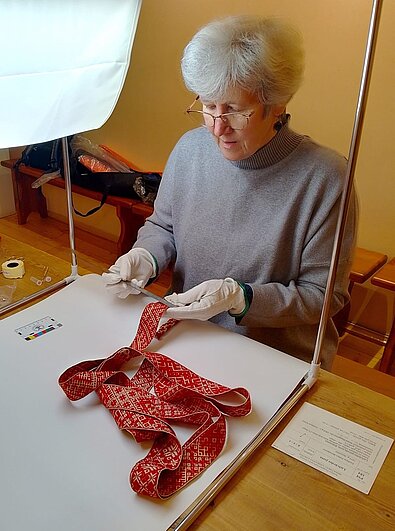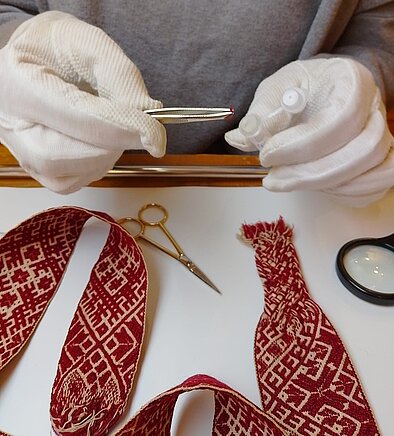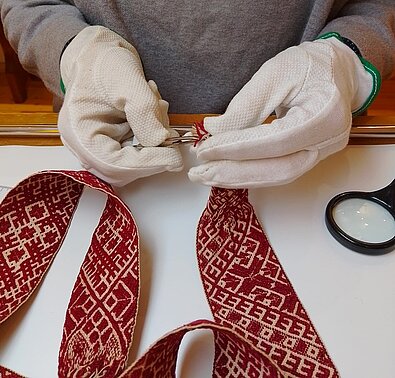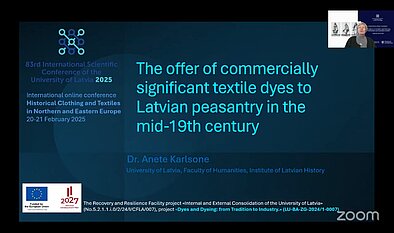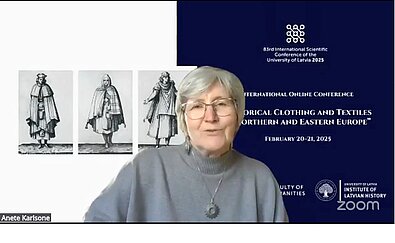Dyes and Dyeing: from Tradition to Industry

Project No.: LU-BA-ZG-2024/1-0007
Implementation period: 01.09.2024.–28.02.2026.
Project costs: EUR 68 961.00
Project leader: Dr. hist. Anete Karlsone
In the history of clothing and textiles, the discovery and introduction of the 19th-century global chemical discovery of synthetic aniline dyes was a significant process. However, this process has not been studied in detail in Latvia until now. In the project, based on the research of written sources, the results of dyeing experiments, and chemical analyses of historical textile samples, new knowledge will be gained about the history of clothing, as well as about the introduction of chemical achievements into society's use in Latvia in the 19th century, reflecting processes in Europe. The implementation of the project will contribute to the general study of the history of clothing, which will allow a better understanding of the processes taking place in society both in ancient times and today. Clothing and the technologies used for its production, including dyeing, reflect the value system, way of thinking, openness to novelties, or, on the contrary, the conservatism of views existing in society in different periods and provide evidence of the directions of information flows.
The goal of the interdisciplinary project, which combines humanities and art sciences with natural science research methods, is to promote public understanding of information flow and technology change processes in the dyeing of textiles and other materials in Latvia in the 19th century, providing new knowledge about traditional cultural heritage and industrial history.
The research results carried out in the project will be made public both through internationally available scientific publications (conference theses, reports, scientific articles), by preparing a monograph, and by organizing dyeing workshops.
Within the framework of the project LU-BA-ZG-2024/1-0007 "Dyes and Dyeing: from Tradition to Industry", the leading researcher of the Institute of Latvian History of the Faculty of Humanities of the University of Latvia, Dr. hist. Anete Karlsone with the paper "Use of alkali in traditional dyeing technologies with plants" participated in the international conference "Dyes in History and Archaeology' 43", which was held in Leeds, United Kingdom from October 23 to 25, 2024. This time the conference was organized by the "Society of Dyers and Colourists" in cooperation with the University of Leeds.
The conference presented the latest discoveries in the research of natural dyes and early synthetic dyes. Chronological reports covered time period from Ancient Egypt to the 19th century, as well as the latest non-destructive or low-destructive dye research methods of the 21st century. A. Karlsone in her report, using the results of practical dyeing experiments, proved that the red color mentioned in the Latvian ethnographic material can be obtained from plants containing tannins only under the influence of alkali. It aroused the interest of archaeologists and other researchers from different countries, as it provided new knowledge about the traditional dyeing methods by which it would have been possible to obtain red shades in ancient times.
Paper sections were held in person, but particients could also follow them and take part in the discussion remotely. The conference was attended by 120 participants (71 of them in person) from 22 countries: Austria, Belgium, China, Czech Republic, Denmark, Estonia, Finland, France, Germany, Italy, Japan, Latvia, Netherlands, Norway, Peru, Portugal, Romania, Spain, Switzerland, United Kingdom and United States of America.

Turpinot pētījumus LU projektā "Krāsvielas un krāsošana: no tradīcijas uz rūpniecību" (LU-BA-ZG-2024/1-0007), ir uzsākta vēsturisko tekstiliju izpēte, ar mērķi iegūt paraugus ķīmiskām analīzēm, kas ļaus noskaidrot tajās izmantotās krāsvielas. Sadarbībā ar Andreja Pumpura Lielvārdes muzeju, Liepājas muzeju un Limbažu muzeju projekta īstenotājai Dr. Anetei Karlsonei ir iespēja iegūt ķīmiskajām analīzēm nepieciešamos, ļoti neliela izmēra dziju paraugus. Ķīmiskās analīzes tiks veiktas LU.
Pētījumu finansē Latvijas Atveseļošanas un noturības mehānisma plāna 5.2. reformu un investīciju virziena "Augstskolu pārvaldības modeļa maiņas nodrošināšana" 5.2.1.r. reformas "Augstākās izglītības un zinātnes izcilības un pārvaldības reforma" 5.2.1.1.i. investīcijas "Pētniecības, attīstības un konsolidācijas granti" otrās kārtas "Konsolidācijas un pārvaldības izmaiņu ieviešanas granti" projekts Nr. 5.2.1.1.i.0/2/24/I/CFLA/007 “Latvijas Universitātes iekšējā un ārējā konsolidācija”.
As part of the project "Dyeing and Dyeing: From Tradition to Industry" (LU-BA-ZG-2024/1-0007), Anete Karlsone, a leading researcher at the Institute of Latvian History at the Faculty of Humanities of the University of Latvia (UL), participated in the international conference "Historical Clothing and Textiles in Northern and Eastern Europe", dedicated to the history of clothing and textiles, which took place as part of the UL 83rd international conference on February 20 and 21, 2025, on the ZOOM platform. The paper "Commercially significant textile dyes for Latvian peasants in the mid-19th century" based on the analysis (textual, contextual, statistical, etc.) of written sources (Latvian press publications) showed the process of the use of textile dyes (both natural and synthetic) that were current in Europe in the territory of the former Vidzeme and Kurzeme provinces, its dynamics and the diversity of available dyes, which could directly influence the development of traditional clothing in the territory of modern Latvia. The paper also traces the entry of the novelty of 19th-century European and world chemical discoveries – aniline textile dyes – into the local Baltic market.
Projekta "Krāsvielas un krāsošana: no tradīcijas uz rūpniecību" (LU-BA-ZG-2024/1-0007) ietvaros Dobeles Amatu mājā 2025. gada 8. un 9. martā notiks Anetes Karlsones vadītā krāsošanas darbnīca “Koši”. Tās uzdevums – iegūt dažādus sarkanās krāsas toņus (references paraugus) vēsturisko tekstiliju krāsvielu pētījumiem. Lai noskaidrotu kodinātāja ietekmi uz konkrētā toņa ieguvi, veiksim dziju iepriekšēju kodināšanu ar atšķirīgas koncentrācijas kodinātājiem dažādās kombinācijās. Krāsosim ar košenilēm jeb košenila bruņutīm (Dactylopius coccus), brazilkoku (Caesalpinia spp) un rubiju (Rubiae tinctorum).
Darbnīcā piedalīsies krāsotājas no Dobeles Amatu mājas, Lielvārdes “Jostu audēju kopas” un Liepājas muzeja.
Pasākumu finansē Latvijas Atveseļošanas un noturības mehānisma plāna 5.2. reformu un investīciju virziena "Augstskolu pārvaldības modeļa maiņas nodrošināšana" 5.2.1.r. reformas "Augstākās izglītības un zinātnes izcilības un pārvaldības reforma" 5.2.1.1.i. investīcijas "Pētniecības, attīstības un konsolidācijas granti" otrās kārtas "Konsolidācijas un pārvaldības izmaiņu ieviešanas granti" projekts Nr. 5.2.1.1.i.0/2/24/I/CFLA/007 “Latvijas Universitātes iekšējā un ārējā konsolidācija”.
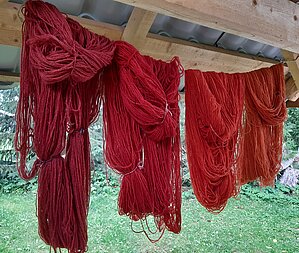
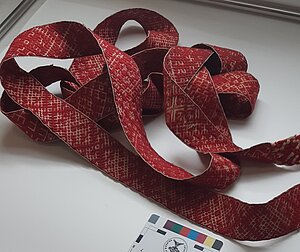
- Navigating the Latvian History of the 20th–21st Century
- Expanding Concept and Methodology for Human Past Studies
- Ethnographer, Society, and Art
- The environment and early farming
- Viking Age in Latvia: an interdisciplinary study
- Burial practices in the landscape
- Skills in synergy, crafts in context
- Dyes and Dyeing
- Magic and Superstition
- Knots in Clay
- Contextualization of Traditional Clothing

 CONFERENCE
CONFERENCE